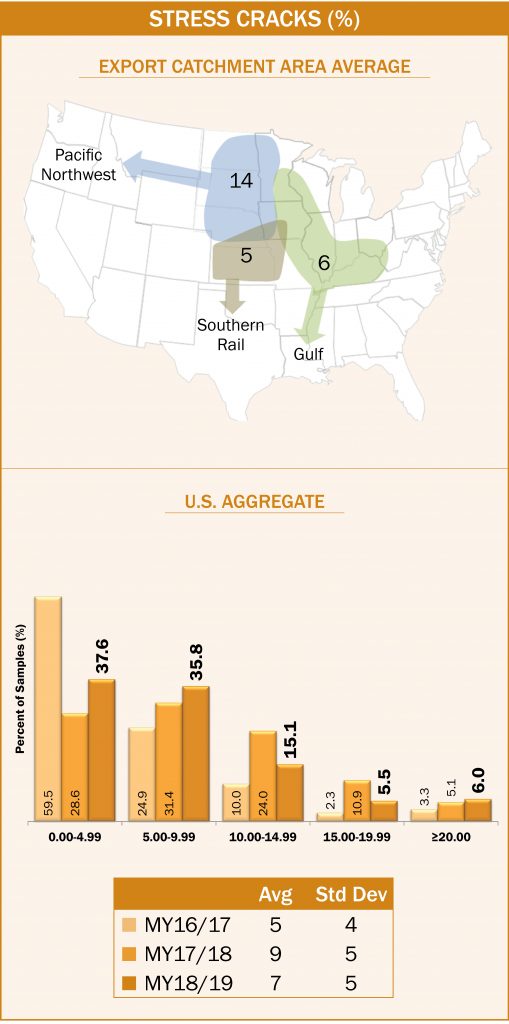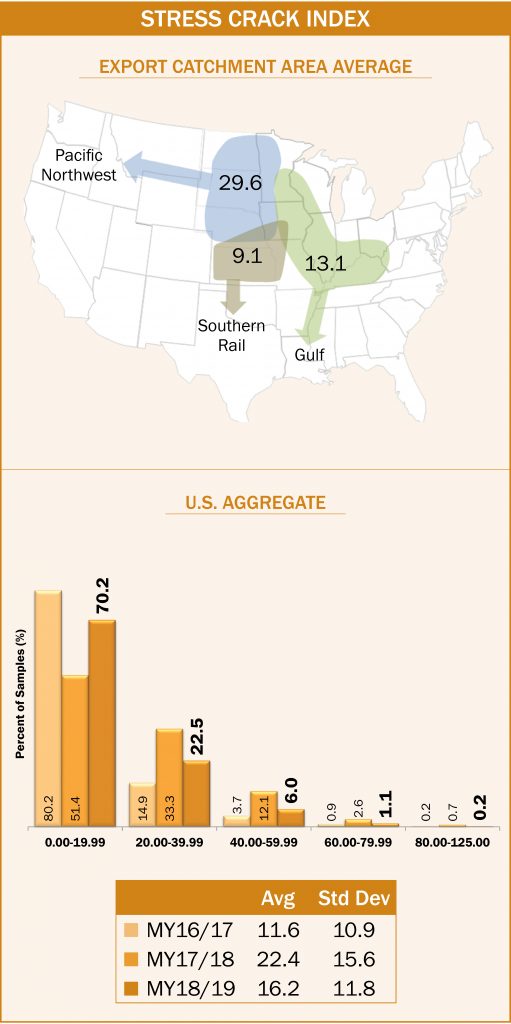Stress Cracks
Stress cracks are internal fissures in the horneous (hard) endosperm of a corn kernel. The pericarp (or outer covering) of a stress-cracked kernel is typically not damaged, so the kernel may appear unaffected at first glance, even if stress cracks are present.
Stress crack measurements include “stress cracks” (the percentage of kernels with at least one crack) and stress crack index, which is the weighted average of single, double and multiple stress cracks. Both measurements use the same sample of 100 intact kernels with no external damage. “Stress cracks” measures only the number of kernels with stress cracks; whereas, the stress crack index shows the severity of cracking. For example, if half of the kernels have only a single stress crack, “stress cracks” is 50% and the stress crack index is 50 (50 × 1). However, if half of the kernels have multiple stress cracks (more than two cracks), indicating a higher potential for handling breakage, “stress cracks” remains at 50%, but the stress crack index becomes 250 (50 × 5). Lower values for “stress cracks” and the stress crack index are always more desirable. In years with high levels of stress cracks, the stress crack index provides valuable information, because high stress crack index numbers (perhaps 300 to 500) indicate the sample had a very high percentage of multiple stress cracks. Multiple stress cracks are generally more detrimental to quality changes than single stress cracks.
The cause of stress cracks is pressure buildup due to moisture and temperature gradients within the kernel’s horneous endosperm. This can be likened to the internal cracks that appear when an ice cube is dropped into a lukewarm beverage. The internal stresses do not build up as much in the soft, floury endosperm as in the hard, horneous endosperm; therefore, corn with a higher percentage of horneous endosperm is more susceptible to stress cracking than softer grain. A kernel may vary in severity of stress cracking and can have one, two or multiple stress cracks. The most common cause of stress cracks is high-temperature drying that rapidly removes moisture. The impact of high levels of stress cracks on various uses includes:
- General: Increased susceptibility to breakage during handling. This may lead to processors needing to remove more broken corn during cleaning operations and a possible reduction in grade and/or value.
- Wet Milling: Lower starch yields due to the increased difficulty in separating starch and protein. Stress cracks may also alter steeping requirements.
- Dry Milling: The lower yield of large flaking grits (the prime product of many dry milling operations).
- Alkaline Cooking: Non-uniform water absorption leading to overcooking or undercooking, which affects the process balance.
Growing conditions will affect crop maturity, timeliness of harvest and the need for artificial drying, which will influence the degree of stress cracking found from region to region. For example, late maturity or late harvest caused by weather-related factors, such as rain-delayed planting or cool temperatures, may increase the need for artificial drying, thus potentially increasing the occurrence of stress cracks.
Results: Stress Cracks
- Average U.S. Aggregate stress cracks (7%) was lower than 2017/2018 (9%) and the 5YA (10%), but higher than 2016/2017 (5%). The lower harvest moisture in 2018 (16.0%) versus 2017 (16.6%) may have, in part, contributed to lower stress cracks found this year.

- Average U.S. Aggregate stress cracks (7%) was slightly higher than the 2018 harvest samples (5%). Average U.S. Aggregate stress cracks has increased from 1 to 4 percentage points between harvest and export for each of the last four years and for the 5YA.
- Stress cracks in the export samples (with a range of 0 to 36% and a standard deviation of 5%) were more uniform than in the 2018 harvest samples (with a range of 0 to 88% and a standard deviation of 6%).
- Of the 2018/2019 export samples, 11.5% had 15% or higher stress cracks, compared with 16.0% in 2017/2018 and 5.6% in 2016/2017.
- Stress cracks averages were 6%, 14% and 5% for the Gulf, Pacific Northwest and Southern Rail ECAs, respectively. The standard deviation of stress cracks was 4% for the Gulf ECA, 8% for the Pacific Northwest ECA and 4% for the Southern Rail ECA.
- Stress crack percentages for contracts loaded as U.S. No. 2 or better (8%) was the same as that for contracts loaded as U.S. No. 3 or better.
Results: Stress Cracks Index (SCI)
- Average U.S. Aggregate stress crack index (16.2) was lower than 2017/2018 (22.4) and the 5YA (25.1), but higher than 2016/2017 (11.6).

- Stress crack index in the export samples (with a range of 0 to 94 and a standard deviation of 11.8) had less variability than 2017/2018 (with a range of 0 to 120 and a standard deviation of 15.6). The 2018/2019 samples had a standard deviation that was slightly higher than that of the 2016/2017 samples (10.9).
- Average U.S. Aggregate stress crack index at export (16.2) was higher than the average U.S. Aggregate stress crack index found at harvest (11.5).
- Average stress crack index was lowest for the Southern Rail ECA (9.1) and highest for the Pacific Northwest ECA (29.6). Average stress crack index for the Gulf ECA was 13.1.
- Stress crack index standard deviations across ECAs were 9.5, 19.0 and 10.5 for the Gulf, Pacific Northwest and Southern Rail ECAs, respectively.
- In 2018/2019, 29.8% of the samples had a stress crack index of 20 or higher, compared with 48.7% in 2017/2018, and 19.7% in 2016/2017. This indicates that the percentage of samples with double or multiple stress cracks was lower than in 2017/2018, but higher than in 2016/2017.
- Stress crack index for contracts loaded as U.S. No. 2 or better (17.7) was higher than contracts loaded as U.S. No. 3 or better (17.1).
